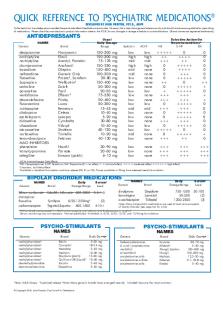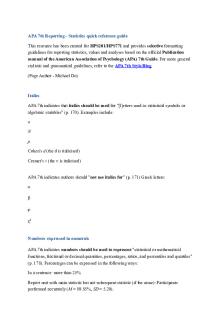Geometric Rules Quick Reference PDF

| Title | Geometric Rules Quick Reference |
|---|---|
| Author | Zinco Tapel |
| Course | college of education |
| Institution | Catanduanes State University |
| Pages | 7 |
| File Size | 785.3 KB |
| File Type | |
| Total Downloads | 65 |
| Total Views | 182 |
Summary
ENJOY...
Description
Geometric Rules Quick Reference - MathBitsNotebook (Geo - CCSS Math)
Geometric Rules Quick Reference [Junior Level] MathBitsNotebook.com Topical Outline | JrMath Outline | MathBits' Teacher Resources Terms of Use Contact Person: Donna Roberts
This is a partial listing of the more popular rules (theorems, postulates, and properties) that you will be using in your study of Geometry. First a few words that refer to types of geometric "rules": • A theorem is a statement (rule) that has been proven true using facts, operations and other rules that are known to be true. These are usually the "big" rules of geometry. A short theorem referring to a "lesser" rule is called a lemma. • A corollary is a follow-up to an existing proven theorem. Corollaries are off-shoots of a theorem that require little or no further proof. • A postulate (or axiom) is a statement (rule) that is taken to be true without proof. Euclid derived many of the rules for geometry starting with a series of definitions and only five postulates. • A property is a quality or characteristic belonging to something. For example, the real numbers have the associative, commutative and distributive properties.
Your textbook (and your teacher) may want you to remember these "rules" with slightly different wording. Be sure to follow the directions from your teacher.
Real Number Properties: Reflexive Property
A quantity is equal to itself. a = a
Symmetric Property
If a = b, then b = a.
Transitive Property
If a = b and b = c, then a = c.
Geometric Rules Quick Reference - MathBitsNotebook (Geo - CCSS Math)
Addition Postulate
If equal quantities are added to equal quantities, the sums are equal.
Subtraction Postulate
If equal quantities are subtracted from equal quantities, the differences are equal.
Multiplication Postulate
If equal quantities are multiplied by equal quantities, the products are equal.
Division Postulate
If equal quantities are divided by equal nonzero quantities, the quotients are equal.
Substitution Postulate
A quantity may be substituted for its equal in any expression.
Segments: Ruler Postulate
Points on a line can be paired with the real numbers.
Segment Addition Postulate
The whole is equal to the sum of its parts. When B lies between A and C on a segment, AB + BC = AC
Midpoint of Segment
The midpoint of a segment is a point on the segment forming two congruent segments (equal segments).
Bisector of Segment
The bisector of a segment is a line, a ray, or segment which cuts the given segment into two congruent segments (equal segments).
Euclid's Postulate 1
A straight line segment can be drawn joining any two points.
Euclid's Postulate 3
Any straight line segment can be extended indefinitely in a straight line.
Angles: Angle Addition Postulate
The whole is equal to the sum of its parts. m∠ABD + m∠DBC = m∠ABC
Right Angles
All right angles are congruent (equal in measure). (They all have a measure of 90º.)
(Euclid's Postulate 4)
Straight Angles
All straight angles are congruent (equal in measure). (They all have a measure of 180º.)
Geometric Rules Quick Reference - MathBitsNotebook (Geo - CCSS Math)
Vertical Angles
Vertical angles are congruent (equal in measure). m∠1 = m∠2 m∠ 3 = m∠ 4
Triangle Sum
The sum of the measures of the interior angles of a triangle is 180º.
Exterior Angle
The measure of an exterior angle of a triangle is equal to the sum of the measures of the two non-adjacent interior angles.
Base Angle Theorem (Isosceles Triangle)
Base Angle Converse (Isosceles Triangle)
If two sides of a triangle are congruent, the angles opposite these sides are congruent (equal in measure). If two angles of a triangle are congruent, the sides opposite these angles are congruent (equal in length).
Angles forming a straight line
Angles around a point
Complementary Angles
Two angles the sum of whose measures is 90º.
Supplementary Angles
Two angles the sum of whose measures is 180º.
Triangles: Pythagorean Theorem
c2 = a2 + b2 In a right triangle, the square of the hypotenuse equals the sum of the square of the lengths of the legs.
Sum of Two Sides
The sum of the lengths of any two sides of a triangle must be greater than the third side. In a triangle, the longest side is across from the largest
Geometric Rules Quick Reference - MathBitsNotebook (Geo - CCSS Math)
Longest Side
angle.
Largest Angle
In a triangle, the largest angle is across from the longest side
Side-Side-Side (SSS) Congruence
If three sides of one triangle are congruent to three sides of another triangle, then the triangles are congruent.
Side-Angle-Side (SAS) Congruence
If two sides and the included angle of one triangle are congruent to the corresponding parts of another triangle, the triangles are congruent.
Angle-Side-Angle (ASA) Congruence
If two angles and the included side of one triangle are congruent to the corresponding parts of another triangle, the triangles are congruent.
Angle-Angle-Side (AAS) Congruence
If two angles and the non-included side of one triangle are congruent to the corresponding parts of another triangle, the triangles are congruent.
Hypotenuse-Leg (HL) Congruence (right triangle)
If the hypotenuse and leg of one right triangle are congruent to the corresponding parts of another right triangle, the two right triangles are congruent.
CPCTC
Corresponding parts of congruent triangles are congruent.
Angle-Angle (AA) Similarity
If two angles of one triangle are congruent to two angles of another triangle, the triangles are similar.
Sides of Similar Δs
Corresponding sides of similar triangles are in proportion.
Parallels: Construction
Through a point not on a line, one and only one parallel to that line can be drawn.
Construction
From a given point on (or not on) a line, one and only one perpendicular can be drawn to the line.
Corresponding Angles
If two parallel lines are cut by a transversal, then the pairs of corresponding angles are congruent.
Alternate Interior Angles
If two parallel lines are cut by a transversal, then the alternate interior angles are congruent.
Alternate Exterior
If two parallel lines are cut by a transversal, then the
Geometric Rules Quick Reference - MathBitsNotebook (Geo - CCSS Math)
Angles
alternate exterior angles are congruent.
Interiors on Same Side
If two parallel lines are cut by a transversal, the interior angles on the same side of the transversal are supplementary.
Quadrilaterals: Quadrilateral
Parallelograms
• a figure with exactly four sides • the sum of the interior angles is 360º About Sides
• opposite sides are parallel • opposite sides are congruent
About Angles
• opposite angles are congruent • consecutive angles are supplementary
About Diagonals
• diagonals bisect each other • diagonals form two congruent triangles
Rectangle
• is a parallelogram • has 4 right angles • diagonals are congruent
Rhombus
• is a parallelogram • has 4 congruent sides • diagonals bisect the angles • diagonals are perpendicular
Square
• has all the properties of a parallelogram, a rectangle, and a rhombus
Trapezoid
• has at least one pair of parallel sides
Isosceles Trapezoid
• has at least one pair of parallel sides • legs congruent • base angles congruent • diagonals are congruent • opposite angles supplementary
Kite
• figure with four sides • two distinct pairs of adjacent sides congruent • diagonals perpendicular • one pair opposite angles congruent • one diagonal creates 2 isosceles triangles • one diagonal creates 2 congruent triangles
Geometric Rules Quick Reference - MathBitsNotebook (Geo - CCSS Math)
• one diagonal bisects the angles • one diagonal bisects the other
Area (A), Volume (V), Surface Area (SA): Rectangle
Arectangle = l × w = b • h l= length; w = width; b = base; h = height
Parallelogram
Aparallelogram = b • h
Triangle
AΔ = ½ • b• h
Trapezoid
Atrapezoid = ½ h (b1 + b2)
Regular Polygon
Aregular polygon = ½ • a • p a = apothem; p = perimeter
C = 2πr = πd
Circle (circumference)
r = radius; d = diameter
Circle (area)
Acircle = πr2
Rectangular Solid
SA formula assumes a "closed box" with all 6 sides.
Cube [special case of rectangular solid]
SA formula assumes a "closed box" with all 6 sides. s = side
Geometric Rules Quick Reference - MathBitsNotebook (Geo - CCSS Math)
Cylinder
SA formula assumes a "closed container" with a top and a bottom.
Cone SA formula assumes a "closed container", with a bottom. s = slant height
Sphere
Right Prism
Vright prism = B • h; SA = 2B + p • h B = area of the base; h = height; p = perimeter of base
Pyramid [assuming all of the faces (not the base) are the same]
B = area of the base; h = height; p = perimeter of base; s = slant height
NOTE: The re-posting of materials (in part or whole) from this site to the Internet is copyright violation and is not considered "fair use" for educators. Please read the "Terms of Use". Topical Outline | JrMath Outline | MathBitsNotebook.com | MathBits' Teacher Resources Terms of Use Contact Person: Donna Roberts Copyright 2012-2021 MathBitsNotebook.com All Rights Reserved...
Similar Free PDFs

Geometric Rules Quick Reference
- 7 Pages

Quick Reference Rules of Law
- 4 Pages

BIWS LBO Quick Reference
- 18 Pages

Psychpharm Quick Reference
- 2 Pages

Oscola quick reference guide
- 1 Pages

GDB Quick Reference (v4)
- 2 Pages

Oscola Quick Reference Guide DMU
- 3 Pages

Statistics Notes- Quick Reference 1
- 100 Pages
Popular Institutions
- Tinajero National High School - Annex
- Politeknik Caltex Riau
- Yokohama City University
- SGT University
- University of Al-Qadisiyah
- Divine Word College of Vigan
- Techniek College Rotterdam
- Universidade de Santiago
- Universiti Teknologi MARA Cawangan Johor Kampus Pasir Gudang
- Poltekkes Kemenkes Yogyakarta
- Baguio City National High School
- Colegio san marcos
- preparatoria uno
- Centro de Bachillerato Tecnológico Industrial y de Servicios No. 107
- Dalian Maritime University
- Quang Trung Secondary School
- Colegio Tecnológico en Informática
- Corporación Regional de Educación Superior
- Grupo CEDVA
- Dar Al Uloom University
- Centro de Estudios Preuniversitarios de la Universidad Nacional de Ingeniería
- 上智大学
- Aakash International School, Nuna Majara
- San Felipe Neri Catholic School
- Kang Chiao International School - New Taipei City
- Misamis Occidental National High School
- Institución Educativa Escuela Normal Juan Ladrilleros
- Kolehiyo ng Pantukan
- Batanes State College
- Instituto Continental
- Sekolah Menengah Kejuruan Kesehatan Kaltara (Tarakan)
- Colegio de La Inmaculada Concepcion - Cebu







